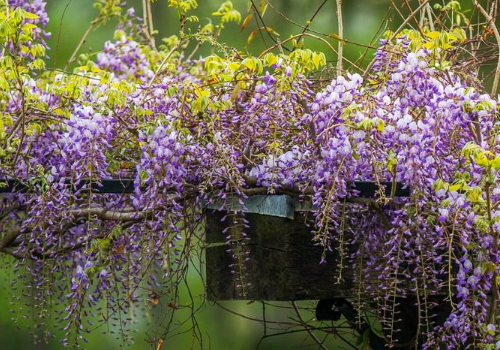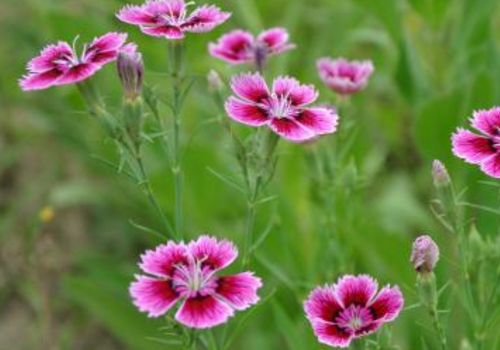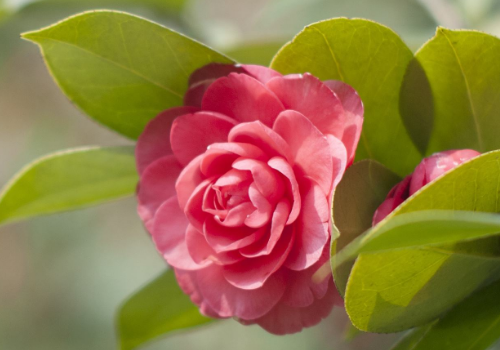How to plant Violet seed and how to prune it
Violet, this is a lot of people are not strange, super many people like, can be good-looking, can grow long, then how to plant this violet seed? How to trim when you grow up:
How to plant Violet seeds:
1. Sowing time
Violet seeds should be sowed in time after maturity, and it takes 2-3 years for seedlings to blossom.
The suitable planting distance is 45-60cm and the planting depth is 7-8cm. It can also promote cultivation.
After sowing, cover with a layer of medium-sized vermiculite. The best PH of Violet is 5.5-5.6. maintain a certain degree of humidity and keep the temperature around 18-21 ℃.
2. Seedling management
After the violet seeds have fully germinated, move the seedling disc to a place with plenty of light and good ventilation.
27000Lux light needs to be provided in the second and third stages of seedling cultivation.
A small amount of nitrogen fertilizer is needed, and the temperature drops to 21 ℃ during the day and 10 ℃ at night. This rule of temperature change should be maintained from the beginning of germination to the growth of the fifth true leaf.
3. Soil and air humidity
Keep the EC value of the violet seed growth soil around 0.7mmhos, supply circulating air and keep the relative humidity around 70%.
4. Violet transplant into the basin
When the seedling has two true leaves, it can be replanted in the pot. The temperature is 15-18 ℃ at the beginning, and it gradually drops to 10 ℃ after a week, and then to about 5 ℃ after a week. It can be maintained and managed by natural temperature in spring, and the fertilizer can be applied normally at this time.

How to trim violets when they grow in vain:
But then again, since it has only grown up, it is necessary to take measures to trim it. Keeping beautiful is the most important thing, isn't it? Violets generally do not need everyone to pick the heart, but if the real leaves grow too much, you can take off a few pieces and keep 6-7 pieces. At the same time, you should also take off the buds at the top, and then keep three or four branches above the side branches. take off the rest. There are some violets because the plant height is too high, after pruning will lead to weak stems and leaves, weak, so flower friends should pay attention to its timely support, so as to avoid plant dumping.
Only if all the overgrown branches and leaves are removed, the part that is most beneficial to the plant and the most aesthetic in appearance will not only increase the number of flowers, but also prolong the flowering time. The above is the specific method of violet pruning, which is very simple and easy to operate. I hope that after reading this article, flower friends can help you build your own home violets and harvest a beautiful pot of potted plants.
This is the end of the introduction to the planting method of Violet seed. This is a long experience. Now you know the pruning method of growing up.
The method of cultivating violets teaches you how to raise violets
Violet, also known as Osmanthus fragrans, Sitaoke, Violet, Violet Bar, Violet Blue, is one of the famous flowers in Europe. So, what is the method of cultivating violets? Today the editor of wed114 Wedding Network teaches you how to raise violets.
Violet
The method of propagation and sowing is mainly, and it can also be propagated by cutting.
Sowing: usually sowed in the basin from September to October, the seeds are small and do not need to be covered with soil or shallow soil after sowing. Sowing should not be dense, otherwise it is easy to suffer from sudden collapse disease. The optimum temperature for germination was 20 ~ 22. After sowing, the pot was covered with glass and germinated for about 2 weeks. Because the double flower is sterile, the seeds can only be collected from the single flower plant in the double flower line. The double flower plant of excellent strain can reach 700 hectare.
Cutting: mainly used for the propagation of double-petal varieties which are not easy to bear fruit.
. Planting and potting: like fertile, loose and well-drained neutral alkaline sandy soil, and avoid acidic soil. It is a taproot plant, which is not tolerant to transplantation and should be broadcast directly. If you want to transplant seedlings, you should take more soil early and try not to hurt the roots. It is appropriate to choose dwarf species for potted plants. After the cotyledons of the seedlings are unfolded, the flowers and seedlings are planted in a pot with a diameter of 10 cm. When there are 6 or 7 leaves, turn the basin into a basin with a caliber of 17cm and 20cm. Pot substrate can be prepared with rotten leaf soil, garden soil, rice chaff ash and other materials.
Violet
Temperature: cool in summer and warm and humid in winter. The optimum temperature for growth is 10-25 °. It has a certain ability to tolerate cold, can endure a low temperature of-5 °in winter, and can overwinter in the open field in the Yangtze River basin, but it is appropriate to put a cold room for pot planting to overwinter. The seedlings must grow at a low temperature of 5-15 °for 18-20 days, otherwise it will be difficult to bloom. The optimum temperature for flower bud differentiation is 15-20 °. Avoid extreme heat, plants often wither and die at high temperatures in midsummer.
Violet
Lighting: like plenty of sunlight, receive 3-4 hours of direct sunlight every day, can make the flowers more beautiful and bloom longer. For long-day shining flowers, if the light time is extended by 4 to 5 hours a day, the plant can blossom ahead of time. It is not resistant to shade, and the plant grows poorly when it passes the shade. But at the height of summer, proper shading is needed to prevent leaves from being burned.
Watering: like the moist soil environment. Because the leaf surface is fluffy, so it is slightly resistant to drought. During the growth period, it should be fully watered to keep the basin soil moist. When it is too dry, the stems and leaves will become smaller and hardened, and the growth is irregular, and the flowering period is delayed. However, avoid watering too much, high temperature and humidity can easily lead to the death of rotten roots. In winter, due to small seedlings, coupled with low temperature, plant growth is not fast, water demand is not much, watering should be done "do not dry do not water". The leaves should be prevented from getting wet when watering, otherwise the leaves will spot and rot.
Environmental humidity: indoor cultivation, the air relative humidity should not be large, otherwise the growth of stems and leaves is weak, and affect the quality of flowering.
Violet
Fertilization: very resistant to fertilizer, topdressing fertilizer once or twice a month during the growth period. Nitrogen fertilizer should not be applied more, otherwise the plant will grow too much, affect flowering, and even only grow leaves without flowering. The application of available phosphorus and potassium fertilizer before flowering can make the flowers blossom brightly. Because the whole body is pilose, use hands to gently lift the leaves when fertilizing, do not let fat and water stain the leaves, otherwise the leaves will spot rot, or even plant death.
Pruning: it is necessary to pick the heart when the seedlings grow 9-10 leaves to make the plant more branched and blossom. When the high dry seed grows to 50 to 60 centimeters, it should be supported on a stand so as not to break the flower stem.
Pest control: diseases and insect pests such as downy mildew, root rot, virus, root knot nematode and Plutella xylostella.
Violet
Frequently asked questions about cultivation:
The main results are as follows: 1. the leaf surface is spotted and rotten.
2. It is usually caused by watering or fouling on the leaf surface.
3. The growth of stems and leaves is weak.
4. The light is too weak and the environmental humidity is too high.
5. Little or no flowering.
6. Too shady; did not go through the stage of low temperature vernalization; too much nitrogen fertilizer was applied.
Violet
Stems and leaves become smaller and hardened.
It is often caused by the drying of the basin soil.
Ornamental and health care functions:
Violet flowers are luxuriant, colorful and fragrant, dwarf species can be arranged in flower beds, flower borders or potted plants, and high dry species can be used as cut flowers. It is one of the important varieties of potted and cut flowers in the international flower market.
The smell of violets can kill tuberculosis, pneumococci and staphylococci, and the smell of flowers can make the impatient mood mild and quiet and make people cheerful and happy.
Maintenance of potted peach blossoms, when will peach blossoms bloom?
Peach blossom is a plant of Rosaceae, which has the unique characteristics of double petals and clusters of flowers of Rosaceae. Where peach blossoms are in full bloom, colorful butterflies are flying, which is extremely charming and beautiful. The fruit of peach blossom peach is also one of the most common edible fruits in China, the sweet feeling makes people nostalgic.
Maintenance of potted peach blossoms, when will peach blossoms bloom? -
[plant archives]-
English name: peach blossom
Scientific name: Prunus persica
Aliases: green peach, peach, peach plum, Yangchunhua
Family: Rosaceae of Rosaceae
Genus: Prunus
Origin distribution: peach originated in China, can be traced back to the Zhou Dynasty, gradually spread to the surrounding areas of Asia, from Persia to the West, the Latin name Persica means Persia.
Morphological features: small deciduous trees; leaves narrowly elliptic to lanceolate, apex growing and thin tip, margin denticulate, dark green glossy, leaf base with nectaries; bark dark gray, cracks with age; flowers solitary, from light to dark pink or red, sometimes white, short stalked, 4cm in diameter, flowering in early spring Subglobose drupe with hairy surface, fleshy edible, orange-yellow and reddish in diameter, 7.5cm in diameter, with deep dots and grooves in stone, containing white seeds.
Conservation of potted peach blossoms-
Peach blossoms like light, should not be shaded, cold-resistant, drought-resistant, afraid of waterlogging, and avoid stagnant water at the root. It is appropriate to choose loose loam with good drainage, not too fertile, otherwise it will grow branches and leaves and blossom less. For potted peach blossoms, more attention should be paid to conservation:
Watering: do not dry do not water, watering the right amount, to prevent stagnant water.
Fertilization: apply liquid fertilizer once or twice a year after flowering and after flowering, but do not apply fertilizer at other times.
Pruning: peach blossoms have the habit of differentiating flower buds in July and blooming in spring the following year. Attention should be paid to pruning. Young peaches mainly develop peach crowns. After flowering, only two or three buds at the base are retained and the rest are cut off. In summer, the overgrown branches are coring to promote the formation of flower buds. For plants that are not growing well, we should avoid too much pruning, restrain the strong and help the weak, and pay attention to the uniform distribution of branches, resulting in a beautiful plant shape.
Change the basin: when the Spring Equinox does it every year. When changing the basin, put some phosphate fertilizer at the bottom of the basin as base fertilizer, cut off the dense roots and fill in the new basin soil.
Pest control: peach blossoms will produce leaf shrinkage disease, which can be prevented by spraying Bordeaux liquid brush and painting tree trunks every half a month at the beginning of the disease. Aphids, moths, longicorn beetles and other pests can be caught manually or killed by spraying pesticides.
When do the peach blossoms blossom? -
Peach blossom florescence in early spring, for the Spring Festival indoor bottle good material, in order to ensure that it blossoms in the Spring Festival, you can carry out flowering treatment. Generally, the pot is moved to a cool place below 7 ℃ after the peach blossom leaves are fallen, and then moved indoors 1-1.5 months before the Spring Festival, giving a temperature of about 10 ℃, and then gradually increasing the room temperature. In the environment of 20-25 ℃, it can blossom after 15-25 days.
Conclusion: through the detailed introduction of this article, do you have a more and deeper understanding of the culture of peach blossoms and the knowledge of when peach blossoms bloom? There are only a few days left for the Spring Festival. Are you ready to plant peach blossoms in your home?
[more Encyclopedia of plants]
Tequila, canna, other flowers, forget-me-not dandelions, Dendrobium candidum, Taxus, kapok, cotton, sweet-scented osmanthus and sea crabapple flowers.
Home fengshui plant bedroom fengshui plant plum blossom aloe jasmine radiation protection plant potted plant potted plant drug plant
Mistletoe indoor flower rich tree evergreen potted production of red palm mint stone flower geranium garden crab claw orchid plain sailing
Tiger Pilan Kunlun snow chrysanthemum water lily flowerpot violet magnolia primrose mimosa blue witch hydroponic cyclamen dripping Guanyin
Ping an tree rich bamboo Jasper fragrant wood rose June snow hydrangea Phoenix tail bamboo mosquito repellent rubber tree Luo Han Song upside down Golden Bell
Ivy big flower Cymbidium, Cymbidium, Yushu, Wanlian, Jiulian, marigold, money string, lily of the valley, sweet-scented osmanthus, tulip, goldfish grass, mandala flower
Morning glory office fengshui plant Longtuzhu Yuzhu Camellia daisy wine bottle epiphyllum
- Prev

What is the difference between how to plant colorful carnation seeds and how to grow carnation in summer?
Colorful carnation, this is also a kind of plant, is a lot of people know, super many people know, then how to plant this colorful carnation seed? What is the difference between carnation and carnation in summer: how to plant colorful carnation seeds: common sowing, cutting and ramet propagation
- Next

How to plant camellia seeds? can you raise them indoors?
Camellia, this is a kind of plant that many people like, super likable, so how to grow this camellia seed? Can you raise it indoors: how to plant camellias seeds: 1. Seed harvesting and storage in autumn when the fruit is slightly cracked, it will be harvested immediately and put in a cool and ventilated place to dry.
Related
- Fuxing push coffee new agricultural production and marketing class: lack of small-scale processing plants
- Jujube rice field leisure farm deep ploughing Yilan for five years to create a space for organic food and play
- Nongyu Farm-A trial of organic papaya for brave women with advanced technology
- Four points for attention in the prevention and control of diseases and insect pests of edible fungi
- How to add nutrient solution to Edible Fungi
- Is there any good way to control edible fungus mites?
- Open Inoculation Technology of Edible Fungi
- Is there any clever way to use fertilizer for edible fungus in winter?
- What agents are used to kill the pathogens of edible fungi in the mushroom shed?
- Rapid drying of Edible Fungi

